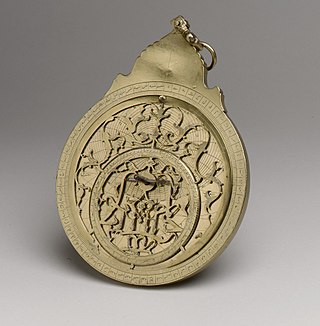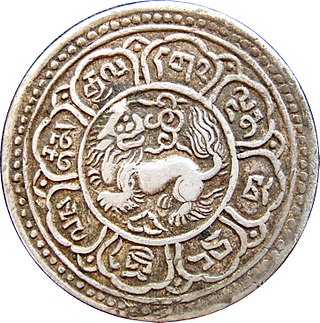Related Research Articles

Brass is an alloy of copper (Cu) and zinc (Zn), in proportions which can be varied to achieve different colours and mechanical, electrical, acoustic, and chemical properties, but copper typically has the larger proportion. In use since prehistoric times, it is a substitutional alloy: atoms of the two constituents may replace each other within the same crystal structure.

Bronze is an alloy consisting primarily of copper, commonly with about 12–12.5% tin and often with the addition of other metals and sometimes non-metals, such as phosphorus, or metalloids such as arsenic or silicon. These additions produce a range of alloys that may be harder than copper alone, or have other useful properties, such as strength, ductility, or machinability.

A metal is a material that, when freshly prepared, polished, or fractured, shows a lustrous appearance, and conducts electricity and heat relatively well. Metals are typically ductile and malleable. These properties are the result of the metallic bond between the atoms or molecules of the metal.

Electrum is a naturally occurring alloy of gold and silver, with trace amounts of copper and other metals. Its color ranges from pale to bright yellow, depending on the proportions of gold and silver. It has been produced artificially and is also known as "green gold".

Cupronickel or copper–nickel (CuNi) is an alloy of copper with nickel, usually along with small quantities of other elements added for strength, such as iron and manganese. The copper content typically varies from 60 to 90 percent.
Cymbals are made from four main alloys, all of them copper-based. These are: bell bronze, malleable bronze, brass, and nickel silver.

Nickel silver, maillechort, German silver, argentan, new silver, nickel brass, albata, or alpacca is a copper alloy with nickel and often zinc. The usual formulation is 60% copper, 20% nickel and 20% zinc. Nickel silver does not contain the element silver. It is named for its silvery appearance, which can make it attractive as a cheaper and more durable substitute. It is also well suited for being plated with silver.

Brazing is a metal-joining process in which two or more metal items are joined by melting and flowing a filler metal into the joint, with the filler metal having a lower melting point than the adjoining metal.

Orichalcum or aurichalcum is a metal mentioned in several ancient writings, including the story of Atlantis in the Critias of Plato. Within the dialogue, Critias says that orichalcum had been considered second only to gold in value and had been found and mined in many parts of Atlantis in ancient times, but that by Critias's own time, orichalcum was known only by name.
Plating is a finishing process in which a metal is deposited on a surface. Plating has been done for hundreds of years; it is also critical for modern technology. Plating is used to decorate objects, for corrosion inhibition, to improve solderability, to harden, to improve wearability, to reduce friction, to improve paint adhesion, to alter conductivity, to improve IR reflectivity, for radiation shielding, and for other purposes. Jewelry typically uses plating to give a silver or gold finish.
This glossary of numismatics is a list of definitions of terms and concepts relevant to numismatics and coin collecting, as well as sub-fields and related disciplines, with concise explanations for the beginner or professional.

Panchaloha, also called Pañcadhātu, is a term for traditional five-metal alloys of sacred significance, used for making Hindu temple murti and jewelry.

Metals used for architectural purposes include lead, for water pipes, roofing, and windows; tin, formed into tinplate; zinc, copper and aluminium, in a range of applications including roofing and decoration; and iron, which has structural and other uses in the form of cast iron or wrought iron, or made into steel. Metal alloys used in building include bronze ; brass ; monel metal and nickel silver, mainly consisting of nickel and copper; and stainless steel, with important components of nickel and chromium.
Silver standards refer to the standards of millesimal fineness for the silver alloy used in the manufacture or crafting of silver objects. This list is organized from highest to lowest millesimal fineness, or purity of the silver.

The use of historical money in Tibet started in ancient times, when Tibet had no coined currency of its own. Bartering was common, gold was a medium of exchange, and shell money and stone beads were used for very small purchases. A few coins from other countries were also occasionally in use.

Group 11, by modern IUPAC numbering, is a group of chemical elements in the periodic table, consisting of copper (Cu), silver (Ag), gold (Au), and roentgenium (Rg), although no chemical experiments have yet been carried out to confirm that roentgenium behaves like the heavier homologue to gold. Group 11 is also known as the coinage metals, due to their usage in minting coins—while the rise in metal prices mean that silver and gold are no longer used for circulating currency, remaining in use for bullion, copper remains a common metal in coins to date, either in the form of copper clad coinage or as part of the cupronickel alloy. They were most likely the first three elements discovered. Copper, silver, and gold all occur naturally in elemental form.
The coinage metals comprise those metallic chemical elements and alloys which have been used to mint coins. Historically, most coinage metals are from the three nonradioactive members of group 11 of the periodic table: copper, silver and gold. Copper is usually augmented with tin or other metals to form bronze. Gold, silver and bronze or copper were the principal coinage metals of the ancient world, the medieval period and into the late modern period when the diversity of coinage metals increased. Coins are often made from more than one metal, either using alloys, coatings (cladding/plating) or bimetallic configurations. While coins are primarily made from metal, some non-metallic materials have also been used.
C41100 Lubaloy is a wrought copper alloy that is composed mainly of copper and zinc. Lubaloy possesses many favorable characteristics making it, and other types of brass, a popular choice in manufacturing. It is a source material in many processes including the creation of electrical components and bullet-making. There are both positive and negative health effects that are associated with the use of this material.

Qing dynasty coinage was based on a bimetallic standard of copper and silver coinage. The Manchu-led Qing dynasty was proclaimed in 1636 and ruled over China proper from 1644 until it was overthrown by the Xinhai Revolution in 1912. The Qing dynasty saw the transformation of a traditional cash coin based cast coinage monetary system into a modern currency system with machine-struck coins, while the old traditional silver ingots would slowly be replaced by silver coins based on those of the Mexican peso. After the Qing dynasty was abolished its currency was replaced by the Chinese yuan of the Republic of China.
References
- ↑ Bue 1991, pp. 26–7.
- ↑ Bue 1991, p. 27.
- 1 2 3 Helmenstine, Anne Marie (27 Dec 2017), "What Is Tibetan Silver?", www.thoughtco.com
- ↑ Fei, Li (Jan 2018), "In the name of "Zangyin (Tibetan silver)": material, consumption and identity in ethnic tourism of China", Tourism Tribune, 33 (1): 74–85, ISSN 1002-5006, archived from the original on 2022-11-28, retrieved 2019-01-08